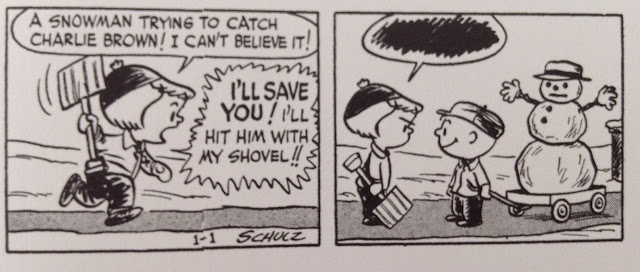Many of the original strips are on display. There is a movie theater featuring animated specials, as well as Schulz interviews and documentaries. And next door, is an adorable ice rink complete with the Warm Puppy Cafe. One of my favorite exhibits in the museum was the recreation of Schulz' office.
I love knowing that one man spent fifty years creating a whole world of characters -- imaginary people we know and love. Figments of someone's imagination, yet figments that have brought a very real joy to millions. That's the dream of every children's book writer and illustrator -- at least, it's my dream.
Oh, and lest I forget to mention, they have a rather mammoth gift shop next to the ice rink. There's just about every sort of plush toy version of all your favorite characters -- except the one my wife wanted to buy. They were all out of Spike!
They also had every edition of Fantagraphics reproduction of the complete Peanuts series, year by year, in chronological order.
I couldn't leave without buying at least one copy, so I purchased the very first one. 1950 to 1952. Are you familiar with how different Charlie Brown looks during the early days of Peanuts? I knew about it -- but was more of a vague awareness. Most of the Peanuts comics I read when I was a kid were from the mid 70s and beyond. So, when I think of Charlie Brown, I think of this guy:
That's a very different look and emotional impact in comparison to the kid on the cover of this book:
Check out the angst! The animosity. The eyebrow! Charlie Brown is known for being the eternal nice guy who never gets a break. Everything always goes wrong for him. His friends treat him unfairly -- even his dog gives him sass. And he's just so nice, it doesn't seem like he deserves it.
Well, if you read the comics from the beginning, you'll notice as I did that some of the above description applies to Good Old Charlie Brown from the very beginning. Here's the first strip we see in the book:
Charlie Brown is a happy-go lucky kid, well-known in the neighborhood. That's Sherman sitting on the steps, next to Patty (the non-Peppermint character). Look how happy Ol' Chuck is... and at first it seems like Sherman is admiring him. But once Charlie Brown has left the panel, Sherman says:
So, from the very beginning Schulz establishes this love/hate attitude possessed by everyone around Charlie Brown. That remains consistent throughout the fifty years of the comic strip. However, as you can tell by Charlie Brown's blank white shirt, he changes.
It's not until several months into Peanuts that Charlie Brown finally appears in his famous zig-zag pattern. Here's the first moment with his icon shirt.
I am guessing that it initially happened just to add something visually interesting to his design. Yet, the zizags become emblematic of his character -- how he feels about himself. His esteem rises and falls throughout the four panels, first feeling hopeful, then confident, then crushed and defeated, but then realizing he can tolerate his life, and that he can even return to that state of hope and start the climb again.
This happens with his unrequited love for the unseen girl with the red hair... it happens with the kite-eating tree, it happens with his baseball endeavors, and it most certainly happens when he tries to kick that football.
If you are like me, you probably think of Lucy as the one who always snatches away the football, right before Charlie Brown can kick it. (And she always seems to do it as a terrible trick.)
But the very first time the football gag occurs isn't with Lucy. In fact, Lucy hasn't even been introduced yet. Violet is the responsible.
But as you can see, she's not snatching the football away in order to cause permanent spinal injury. She's worried about her own safety, and chickens out.
In these early days, Violet is one of the nicer characters, often making mud pies on Charlie Brown's behalf. Not all the characters treat Charlie as kindly. Case in point:
But, you needn't feel too bad for young Charlie Brown. Sure, he gets a black eye in this panel. But in many other early strips, Charlie Brown is a little stinker who intentionally drives Patty crazy!
In the early 1950s, Peanuts featured a running gag in which Charlie Brown would say something insulting to Patty, and then Patty would angrily chase him while he joyfully ran away.
He's a little scamp, not too dissimilar from Calvin -- the imaginative little upstart who loves to infuriate Suzie.
Another similarity between Calvin and Charlie Brown: they share a fondness for creative snowman construction.
* * *
* * *
Early Charlie Brown is precocious. This is before he develops the defeatist expression of "Good Grief!" In the 50s, he's a bit of a prankster. People may give him hell, but he gives it right back.



















